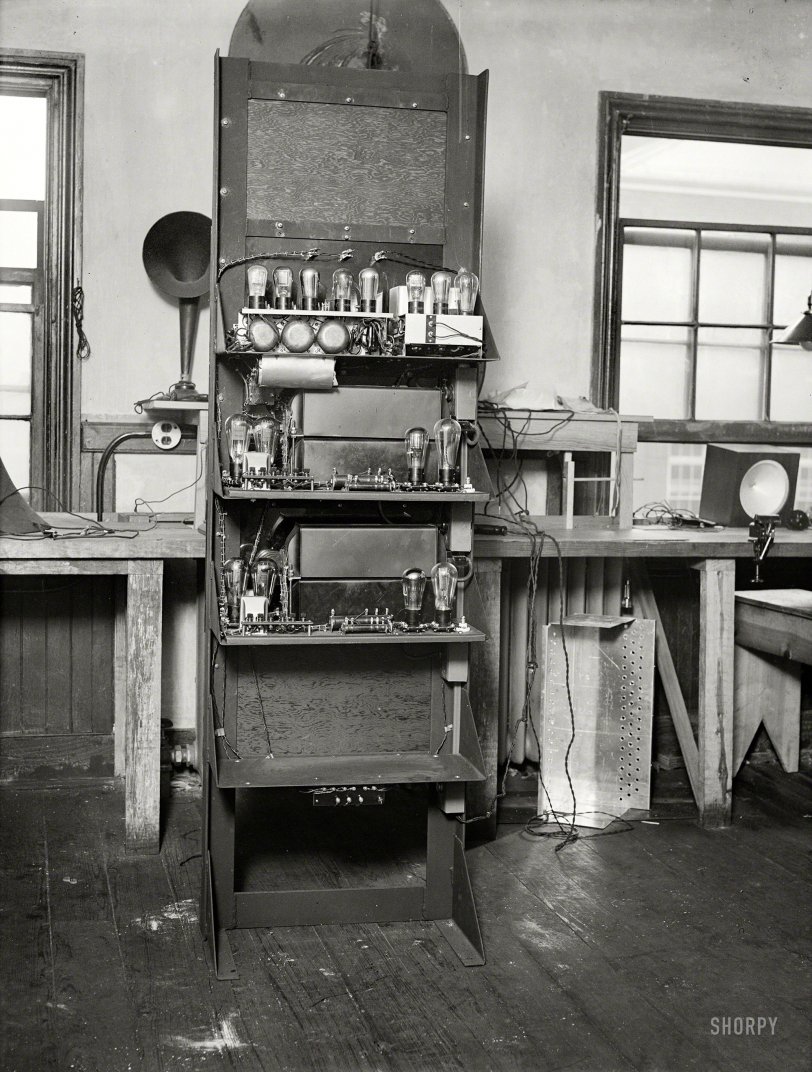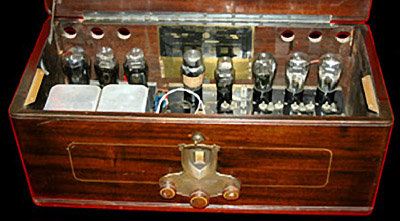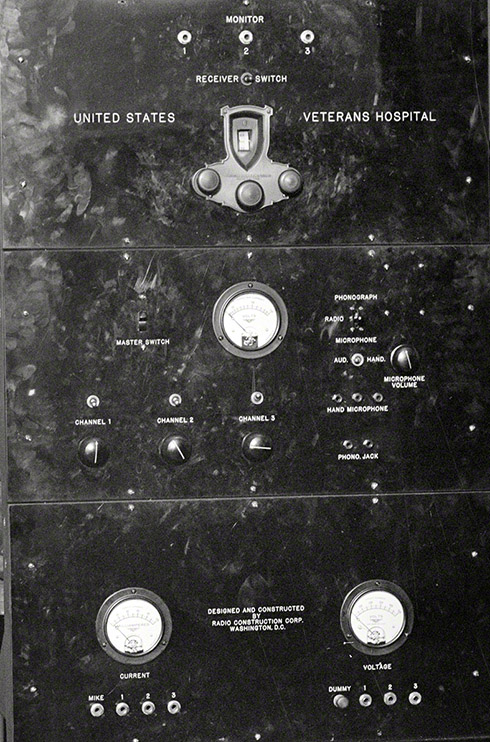


Framed or unframed, desk size to sofa size, printed by us in Arizona and Alabama since 2007. Explore now.
Shorpy is funded by you. Patreon contributors get an ad-free experience.
Learn more.

- Freeze Frame
- Texas Flyer wanted
- Just a Year Too Soon
- WWII -- Replacing men with women at the railroad crossing.
- Yes, Icing
- You kids drive me nuts!
- NOT An Easy Job
- I wonder
- Just add window boxes
- Icing Platform?
- Indiana Harbor Belt abides
- Freezing haze
- Corrections (for those who care)
- C&NW at Nelson
- Fallen Flags
- A dangerous job made worse
- Water Stop
- Passenger trains have right of way over freights?
- Coal
- Never ceases to amaze me.
- Still chuggin' (in model form)
- Great shot
- Westerly Breeze
- For the men, a trapeze
- Tickled
- Sense of loneliness ...
- 2 cents
- Charm City
- What an Outrage
- Brighton Park
Print Emporium
The Apparatus: 1929

UPDATE: See the front panel here.
Summer 1929 or thereabouts in Washington, D.C. An impressive rack. Of what? Unlabeled Harris & Ewing glass negative, Part 1 of 2. View full size.
Dry cell?
M2 commented on the "No. 6 dry cell". Is that what's slung underneath the radio - the thing I misidentified as a filter capacitor?
I thought battery vs AC radios were sort of an "all or nothing" thing; either it ran totally on AC or totally on batteries. Maybe I am confused about that. If this rig needs more batteries, it might make sense that they go on the floor, and the terminals under the bottom shelf are for hooking them up.
Or maybe the dry cell is the only battery in the rig, and it's there for something relatively low-current, like maybe biasing the microphones?
Unfair!
A little unfair Dave. We loyal Shorpy fans can only go by what is visible to us. Obviously the radio's components were inside a metal enclosure out of our view. What was visible were the audio amplifiers used to distribute the sound about the hospital so I think my conjecture it was part of a PA system was valid.
[The radio components are right there in front of your nose on the top rack! American Bosch Magneto Model 28. -Dave]
In my defense, the radio's RF coils and tuning components were not visible from the rear. Of course, had we seen the front view it would be obvious it was a radio.

The same but different
When viewing the back of the rack (1 of 2) the bottom two units appear to be identical. However the front view (2 of 2) shows that these same two units have completely different front panels.
The Rest of the Story
Click here to see the front panel. The top unit is an American Bosch Magneto radio receiver.

Early Television
That big disc reminds me of early mechanical television. But it would need a fairly big electric motor behind it, as well as a neon glowlamp.
Dual chassis were another hallmark of TV setups at the time. You needed separate receivers for audio and video.
No tuning caps might mean a closed-circuit demo rig, not meant to pick up over-the-air signals.
Almost certainly audio equipment
The "tuning capacitor" on the uppermost unit which KCGuy pointed out is a selenium rectifier - one of the first solid state devices in use. It's probably rectifying a bias voltage for the tubes.
I'd discount the likelihood that this rack is radio equipment - at least, not the radio frequency part of it. The two identical large units have no connectors which would be used with radio frequency signals. The only outputs visible are screw post terminals, which would be consistent with audio frequency signals. The three jacks we can see on the top unit (from the back) are the standard quarter-inch phone plugs which were used for audio right through the 20th century - since they're up so high and are on the front of whatever this is, I'd guess they're test jacks or places to plug in headphones or speakers for testing or local monitoring.
Rack System!
The predecessor to today's rack systems used by those IT nerds out there...think about the heat radiating off this monster!
Server (of sorts)
because it's in a 19-inch rack mount,verified by scaling up from the No. 6 dry cell (as opposed to less common 23-inch telco equipment racks).
Talkie equipment
I see speakers but no microphones, and nothing that looks like antenna leads. I'd suggest this is equipment for playing sound in a movie theater. Second suggestion, it's part of a studio's sound recording equipment.
Pots???
Probably not a receiver as there is a shortage of tuning components on these chassis - the upper unit may be a mixer of some type (power supply on the right) - the three round shiny things may be pots or potentiometers (volume controls), there appear to be three input jacks just above the top unit and the two units on the lower shelves are likely two amplifiers that fed two separate speaker systems. The lower empty shelf looks ready to receive the third amplifier. This is obviously the forerunner of Muzak, to be used in a building with 3 elevators.
Quite obvious
This is the first dual line iPhone. With nifty techno-geek carrying case.
Vacuum Tubes
As a lad on Long Island I had a 5-tube Crosley superheterodyne receiver that could pull in race results from all over and even a Cincinnati ball game at night when the cloud cover was good for a "skipping" AM signal but these tubes have me awestruck.
Either a PA system or a two-way radio base station
Here's my guess:
The whole rig is either a public address system, or something like a base station for a police radio system.
The top device is probably a tunable radio receiver. I can see what looks like a tuning capacitor behind a couple of the tubes on the left. The three tubes on the light-colored chassis on the right are probably part of the power supply, while the five tubes on the left are the RF/IF/AF part of the radio. I'm not sure what the three biscuits are, under the tubes at the left - maybe covers over the back sides of rotary controls? The cylinder slung under the left side is probably a filter capacitor for the power supply - it is rather bigger than most radios would have used at that time. Maybe this is designed for a 25 Hz supply? That bright sheet-metal piece standing on end under the workbench is probably the shield for this device.
The top device might also be a powered microphone mixer, to allow multiple microphones to drive the power amps.
If the whole thing is a PA system, and this is a radio, this lets you play background music. If it's a mixer, it lets you use more than one microphone. If it's a base station, then this is probably a radio, and this is how you hear the mobile units calling in.
The bottom two devices are either audio power amplifiers (PA system) or radio transmitters (base station). If they are power amps, they probably amplify the output of the radio for loudspeakers. If you need to cover a bigger area, add another amp to the rack (note the empty shelf). If they are power amps, the dark oblong boxes might be audio output transformers, but I'm not 100% sure on this. (If this was 30 years later, they might be spring reverb tanks, but I don't think those existed in 1929.)
If they are radio transmitters, my guess is that they are fixed-frequency; at that time, those were easier to build, and are always much easier to use. They might even be just CW, for Morse code, but 1929 sounds a little late for that. If they are fixed-frequency, my guess is that they are on two different frequencies; you *could* use the same frequency into two different directional antennas, but that requires synchronization of the transmitters that I am not sure was reliable in 1929. I'm not sure what the dark oblong boxes do, if these are transmitters.
There are three jacks (probably for 1/4" phone plugs) above the top device. I bet these are for headphones, a microphone, and maybe a push-to-talk switch. If it's a PA system, someone standing at the console can monitor the output, and the microphone and PTT let you cut out the music and make announcements. If it's a base station, then you listen to the mobile units on headphones, and use the microphone to transmit.
There is a small terminal board under the bottom shelf. I am not real sure what this is for - it might be the antenna terminals for the radio on the top shelf, or maybe it's some control and switching lines for the whole rack, that can be used to tie more than one of these racks together.
The AC power comes in at the bottom right and runs up the rack, with an outlet for each shelf. The outlet boxes and conduit look a lot like the stuff that is sold today as Wiremold(R) surface-mount conduit. The whole rack is not that much different than a "relay rack" you might use today to mount Ethernet jacks, switches, routers, etc; the main difference is that the shelves on modern racks usually bolt in rather than weld on. The power (if equipped) still tends to run up one side.
Not radio
These appear to be audio (sound) amplifiers. I see tubes and wire-wound resistors- but no RF coils or tuning capacitors like radio equipment would have. My guess is it's part of a early PA system.
Backside
I think this is the backside of the equipment rack. I am betting that the next image (2 of 2) will show us the other side and give us more clues.
It's not RF
It's an audio amplifier of some sort -- possibly for a PA system. This is because of the rack mounting.
The reason I say it's not RF is that there is no evidence of tuning capacitors, plus the transformers are definitely audio finals.
While not my era, I'd certainly love to hear from someone who knows about this equipment.
First Mobile Phone
It's either the first mobile phone or the first microwave oven. Or not.
CAGE
The first Electric Analog Grandfather's Clock? Being that it's Washington DC, it was probably classified:
CLOCK, ANALOG, GRANDFATHER, ELECTRIC (CAGE)
Not stereophonic.
My guess is the two sets of identical apparatus work in series. First set picks up weak signals and amplifies them, second set amplifies them even more. Or both sets amplify the same signals and then combine the signals through superheterodyne action. Believe this receiver would be connected to a pretty good-sized antenna/set of antennas, which would allow worldwide reception.

Hi-fi
Two of the shelves have identical apparatus, so obviously it's stereophonic. (I don't really have to insert a smiley face here, do I?)
A radio and so much more
For any Shorpy-ites who complained that recent radio pictures didn't show wiring, this one does. And there's even a speaker in this photo, and it's connected to this seemingly powerful receiver and / or transmitter.
























On Shorpy:
Today’s Top 5